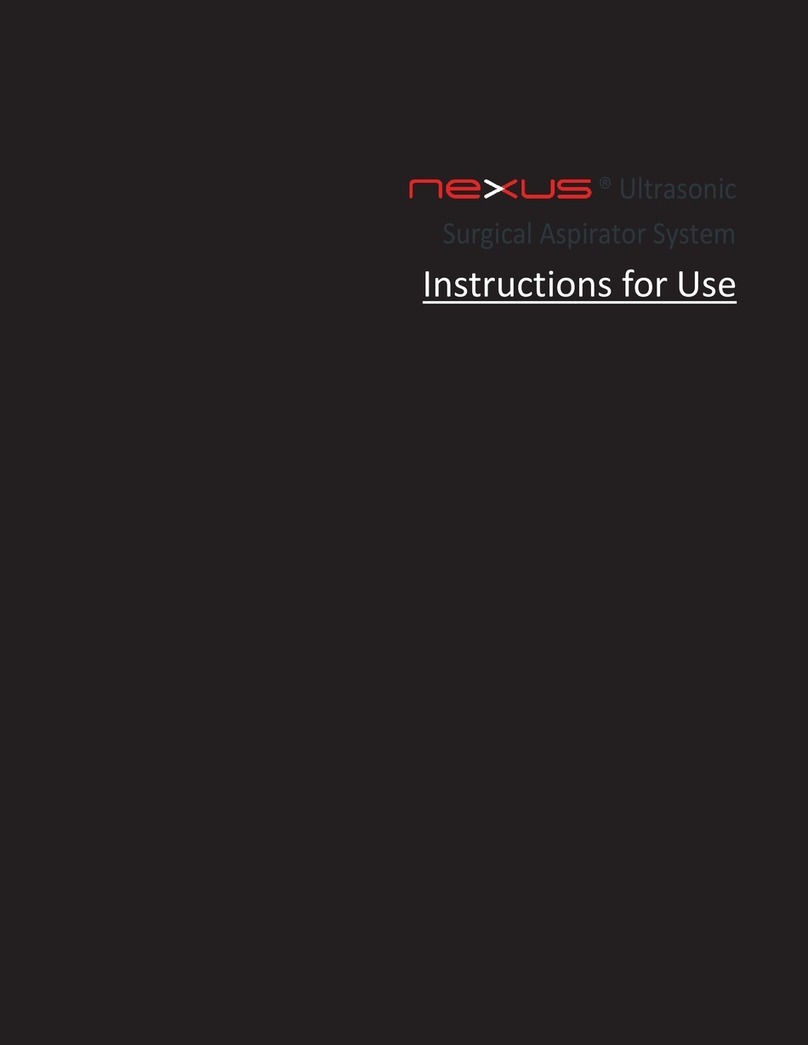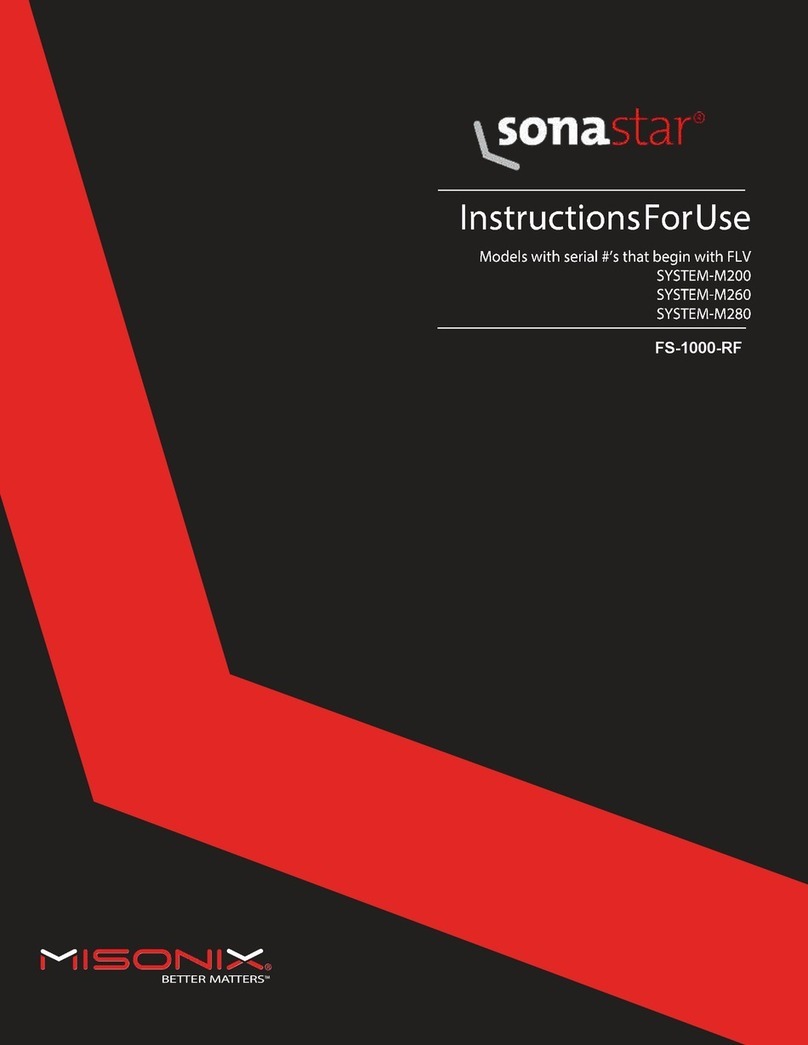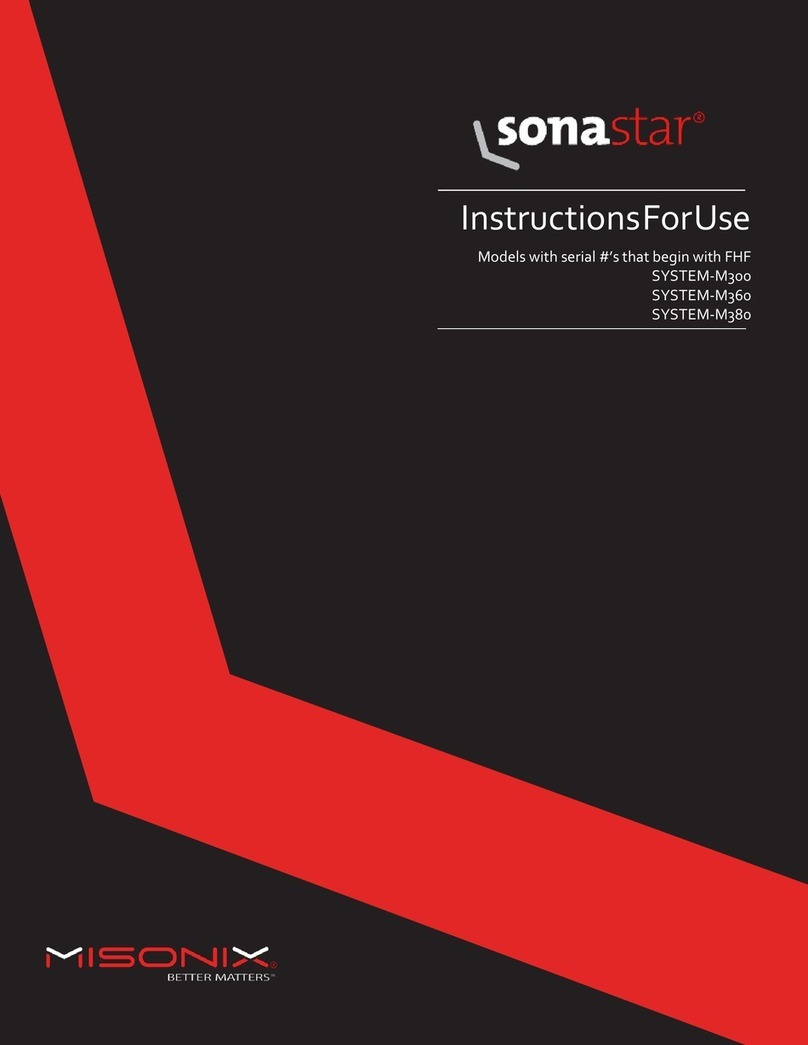List Of Warnings
WARNING 1.1 The SonicOne CLINIC system is an electro-mechanical device, which under certain circumstances could
present an electrical shock hazard to the operator and/or patient. Please read manual thoroughly and follow
directions stated herein to assure maximum safety during operation. This manual shall be kept in close
proximity to the system for easy referral when needed.
WARNING 1.2 The SonicOne CLINIC system is intended to be used in various types of invasive, surgical procedures. There
may be indirect danger to the patient should the device fail during the procedure. It is recommended that
the facility follows its back-up equipmentprotocols.
WARNING 1.3 The SonicOne CLINIC system generates high voltages within the console itself and the connected handpiece.
To avoid injury, the console should never be operated before ensuring that its cover is properly closed and
not tampered with. Do not attempt to remove or disassemble the cover. There are no user-serviceable parts
inside the console. All service should only be performed by an authorized Misonix representative. No
modification of this equipment is required.
WARNING 1.4 Proper system grounding can only be ensured when an approved, hospital-grade receptacle and matching
power cord are used. To avoid the risk of electric shock, this equipment must only be connected to a supply
with protective earth. Install plug and receptacles as per local regulations before operating the unit. Power
cord, plug and receptacle should be examined to verify that they are in good working condition before
connecting the console. Never pull on the power cord to remove it from the receptacle.
WARNING 1.5 Connecting the console to the power outlet with inadequate voltage or frequency may cause the unit to
malfunction or to create a shock or fire hazard. Confirm that the voltage selector switch on the console
rear panel is set to the location voltage setting and ensure that the correct fuses are being used. Refer to
section 12.1 on instructions for fuse replacement.
WARNING 1.6 Remove handpiece front housing and ultrasonic probe from the handpiece prior to cleaning and
disinfection or sterilization; otherwise proper cleaning and disinfection or sterilization may be inhibited.
WARNING 3.1 Tip and irrigant temperatures may exceed the tissue necrosis point if insufficient irrigation flow rates are
used. For hard tissue removal, set the irrigation flowrate to a setting no less than the comparable
vibration setting. For example, if the vibration setting is 7, a minimum flow setting of 70% should be used.
Additional external irrigation, e.g. by administering sterile saline with a syringe over the distal tip portion,
may be necessary for removal of very dense, hard osseous structures.
WARNING 3.2 Tissue necrosis may result if tip is not moved relative to tissue. A continuous, lateral sweeping motion is
recommended in order to minimize contact duration with the ultrasonic tip and minimize heat build-up.
When lateral motion is not possible withdraw and re-insert tip frequently.
WARNING 3.3 The SonicOne CLINIC system and its accessories may emit harmful acoustic pressure if exposure
exceeds recommended limits. Wear hearing protection or protect patient hearing if not within the
exposure limits.
WARNING 3.4 For the Wide Hatch Probe: Less than 50” (127 cm) tall patients to wear ear protection during debridement.
All other patients, to wear ear protection only for upper body debridement.
WARNING 4.1 Contact to vibrating elements like extension and ultrasonic tip may cause burns and should be avoided by
all means. The handpiece should only be held at the black housing area. An optional, protective silicone
sleeve, included with certain tips, reduces the risk of thermal damage but does not eliminate it. Contact
with the silicone sleeve should be avoided or kept brief with minimal amount of contact pressure. Pressure
and extended exposure can still result in excessive frictional heat and cause burns.
WARNING 4.2 Ultrasonic tips can break under excessive use in extreme conditions, e.g. when cutting for extended /
duration in tight cavities with limited lateral motion. The tip could break into two or more fragments with
the main fragment remaining attached to the handpiece. All fragments must be retrieved immediately from
the surgical site. The fragments should be checked to ensure that no further pieces are missing. It is possible
that a fragment is propelled outside of the surgical cavity. Diagnostic imaging, such as X-ray, must be used if
a fragment cannot be found to confirm that the broken piece is outside of the surgical cavity.
WARNING 4.3 Breakage of ultrasonic tips will result in sharp edges that can be harmful to soft tissue even without
activation of ultrasound. Tips can bend or deform before they actually brake. Tips showing signs of
deformation or cracking should be replaced immediately since tip breakage is otherwise imminent. Do not
bend or twist the ultrasonic tips since it reduces the structural integrity and can result in tip breakage
during use. Dispose of deformed or broken tips immediately in a sharps container.






























